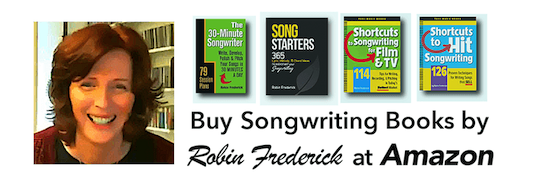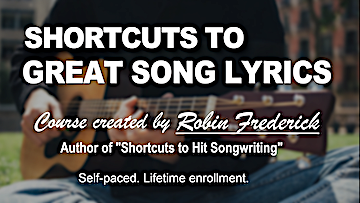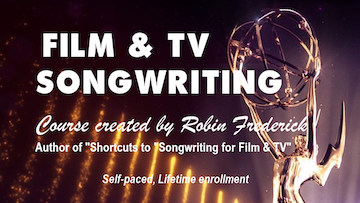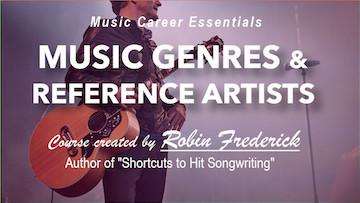Until recently you would only have heard a thoughtful, acoustic-based folk song like “Let Her Go” on college radio stations or eclectic NPR shows. Certainly not among Billboard’s Top 10 Pop hits. But there it is. If you haven’t heard this song on the radio then you’ve probably heard it on a national TV commercial or featured in prime time television series like Elementary and The Vampire Diaries.
Let’s take a deep dive into this song to see what makes it work so well and how you can use some of these techniques in your own songs.
TECHNIQUES TO HEAR AND TRY:
- Use examples to express theme and emotion.
- Start a song with a chorus.
- Use a three-line melody pattern.
- Create a slow dynamic build with production.
Listen to the song. Read the lyrics.
Artist: Passenger
Songwriter: Michael David Rosenberg (aka Passenger)
Watch on YouTube.
Read the lyric here.
GENRE/STYLE: Folk, Singer-Songwriter
(What is a genre? Watch this video.)
The lyric, melody, and structure of this song are all reminiscent of the folk genre, with a nod to both authentic English ballads and the folk songs of the 1960s. If you still love to sing “Where Have All the Flowers Gone” then this song is for you! There’s even a subtle group sing-along on the chorus, almost as if everyone is gathered round the ol’ campfire.
But even though the retro underpinnings are clearly there, the melody has interesting twists that give it a modern edge. If you’ve got a few old fashioned folk songs tucked away (and I know some of you do) consider giving them a facelift with these tricks.
SONG STRUCTURE
The song structure is…
CHORUS / VERSE
CHORUS / VERSE
CHORUS / BRIDGE (built on the last line of the chorus)
CHORUS – 2x
STARTING A SONG WITH A CHORUS: Opening with a chorus. (“You only need the light when it’s burning low…”) is an unusual choice in today’s hit songs and here’s why: The chorus is the emotional heart of your song. It’s all about feelings. When you open with a verse, you lay the groundwork for those feelings, giving the listener insights into the situation and emotions so the chorus has more impact when it finally arrives. Starting the song with a chorus doesn’t give listeners this context. They don’t know why the singer feels the way he or she does.
Furthermore, starting with the chorus doesn’t give the song a chance to build tension that can be released in the chorus. It’s a risky choice to go with the chorus first. But that doesn’t mean you can’t do it. Just be sure you have a compelling chorus lyric that stands on its own without any foundation needed.
THE BRIDGE: The bridge section (at 2:48) is really just a repeat of the last line of the chorus developed through three lines of chord and melody changes. Very simple but it works because the lines are so emotional they provide the peak moment that is so often the job of the bridge.
FINAL CHORUSES: After the bridge there are two repeats of the chorus, with the final four lines being sung with no accompaniment at all.
Notice the dramatic pause before the final line of the opening chorus and final chorus, before he sings “and you let her go.” The pause sets up the phrase, giving it importance. Try adding a pause in your melody before the final phrase of your chorus. Many hit songs do it.
LYRICS
There’s a long tradition of folk songs that feature lists and riddles, songs like “Hush Little Baby,” and “I Gave My Love a Cherry.” A few recent hit songs like “Cannonball” by Damien Rice and “The Riddle” by Five for Fighting share similarities with these traditional lyrics.
USE EXAMPLES: In “Let Her Go” the lyric lists a string of regrets. All of the lines in the chorus make the same point, using different examples to express the idea that we only value a thing once it’s gone. The singer doesn’t make a direct statement until the very end.
Examples help us feel and experience what a song is about rather than telling us how we should feel. You know the old writer’s rule: Show. Don’t Tell. Well, it applies to songwriting, too.
Listeners have experienced what it feels like when the sun goes down and the world becomes dark and cold. By comparing that to what it feels like when you “let her go” listeners can understand the feeling. Concrete examples, images, and physical sensations are the best way to make listeners experience your message and keep them involved in your song.
Read more about using images and examples to get listeners involved.
KEEP THE FOCUS TIGHT: Try keeping your chorus focused on just one feeling or idea. Take the listener deeper into how it feels or what you think about it. One of the biggest mistakes we make when writing a song is to try to express TOO MUCH in the chorus. Pick one idea, feeling, or situation and explore it. Make sure it’s the central idea of your song.

USE A FAMILY OF IMAGES: The images in the chorus of “Let Her Go” are basic, simple objects: a candle, the sun, a road. In the verses, the images suggest a lonely, quiet interior: “staring at the bottom of your glass,” “staring at the ceiling in the dark.” All the images seem to come from the same world, stripped down to the bare essentials. No frills, just the raw truth. It’s this sense of being left with only a handful of elemental images that gives the song its strength and feeling of authenticity.
As a songwriter, images are one of the most powerful tools you have. But if you just throw a whole bunch of them into your song, you could end up with a lyric that feels disconnected and confusing. Listeners don’t know what to focus on or what to feel. Try choosing images that come from the same family, ones that share a sense of time, season, place, or emotional tone.
For example, you could stick with simple, organic images like this song does. Or, if your song is more complex, go for urban images of city streets, crowds, traffic, and noise. Or try a palette of fantasy images – magical, spiritual, or haunted – for a song about soul mates.
Listeners like to get into a mood or vibe and stay there for a while. Quick shifts in images don’t work well for them. Use a family of images to take listeners deeper into a feeling or idea. Put images that are unconnected into different sections of your song or keep them a few lines apart.
MELODY & CHORDS:
The verse and chorus melodies in “Let Her Go” don’t have a lot of contrast. You don’t hear the huge rise in note range from verse to chorus that characterizes big radio hits by artists like Kelly Clarkson or Katy Perry. But there’s a more subtle type of contrast that has to do with the chord progression. Here are the chords…
CHORUS: | F | C | G | Am | F | C | G | G | – 2x
VERSE: | Am | F | G | E m | Am | F | G | G | – 2x
In both verse and chorus, the chords are similar and change on the first beat of each bar. The only difference lies in the emphasized chords in each section. Notice that the verse starts on a minor chord (Am) while the chorus begins on a major chord (F).
The emphasis on the A minor chord gives the verse a more sorrowful feel. Then, when the song moves to the opening F chord of the chorus, the song lifts a little, feeling lighter and more hopeful. It’s this shift from minor to major that creates a subtle but effective contrast between sections.
MELODY: Here’s where this song adds a contemporary edge that sets it apart from vintage folk songs.
=> Verse and chorus melodies are divided into groups of three lines.
Generally, we’re more used to hearing groups of two or four lines rather than three. Think nursery rhymes like “Twinkle, Twinkle Little Star” or greeting card poems. A three-line pattern feels a little unbalanced. It keeps us waiting for what comes next. Instead of a fourth vocal line, there’s an instrumental break and a long pause in the vocal. It gives the song a slightly lop-sided feel.
=> There are very short pauses between the lines in each pattern.
Most of the melody phrases begin on Beat 4 and end in the middle of the next bar, just before the next phrase starts. This creates a lot of forward momentum during the three-line groups. This is much more typical of today’s singer-songwriter melodies than traditional folk songs.
=> Most melody phrases begin on Beat 4.
Many traditional songs start melody phrases on or just after Beat 1, when the chord changes. We have a natural tendency to start singing when we change the chord. But everything in the chorus melody of this song is shifted one beat earlier. It surprises us and keeps the melody interesting. The verse melody mixes starting points, though most lines still begin on Beat 4.
If you have a tendency to start melody phrases when you change chords (and who doesn’t!) practice singing and playing along with this song to give yourself a feel for early phrase starts.
As the song moves along, the singer plays with the melody, improvising and raising it higher in the second verse. Even while he does that, he still maintains the three-line groups and the same phrase starts, keeping the melody interesting but recognizable for the listener.


PRODUCTION
The instrumental arrangement of this song has a clear dynamic build that reaches a peak then dwindles away to nothing, literally, at the end of the song. The opening chorus is sung over a simple synth bell, pad, and acoustic guitar then the full band comes in for the first verse. On the second chorus a couple of solo violins enter. The third chorus includes a group of singers, mixed in the background, giving the song it’s sing-along flavor.
The strings, band, and background vocals reach a peak in the chorus after the bridge. Then everything gradually drops out in the last chorus, leaving the singer alone for the final lines.
This slow, steady dynamic build is an interesting production concept that might work for one of your singer-songwriter songs. Print out the lyrics and make a note all the instruments that enter or drop out in each section. Then try a similar arrangement pattern in a song of your own.
VOCAL: The vocal is unique, personal, and intimate. It features conversational phrasing, almost as if the singer is talking directly to the listener.
To give your vocal a better chance of connecting with listeners, try speaking the lyric lines with emotion just before you record them. Imagine yourself talking to someone as you sing.
Here are seven tips for getting a great vocal performance in today’s singer-songwriter style.
In your mix, be sure the vocal has plenty of volume and presence. Keep the instruments out of the way of the vocal by rolling off mid-range EQ (1 to 2.5 kHz) and panning them toward the left or right. Use “Let Her Go” as a reference track for your mix. Play it at regular intervals and compare it with your mix. See how close you can come to it.
ARTIST NAME
“Passenger” is the artist name of singer-songwriter Mike Rosenberg. Originally Passenger was a four-piece band. After the other members dropped out, Rosenberg kept the name. Other solo singer-songwriters, like Five For Fighting or A Fine Frenzy, have made a conscious decision to use a name that sounds like a group, even when there was no group to begin with.
If you’re a singer-songwriter, using a name that sounds like a group instead of your own name might be something to consider. It could give you the opportunity to express the emotional feel of your music right up front. On the other hand, some people feel it’s more authentic to use the name you were born with. But if your birth name doesn’t fit the style of your music, or is extremely difficult to spell or remember, or is identical to that of an established artist, this is an option.
TRY IT NOW
Write a melody with phrases that begin on Beat 4. Or write a melody based on three-line patterns.
Create a song title or an idea you want to write about. Write down the most important thing you want listeners to understand or feel about your idea. Make a list of examples and images that express it.
READ MORE HIT SONG GUIDES ON THIS SITE and learn from the hits!

